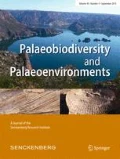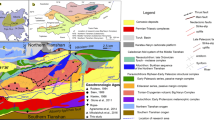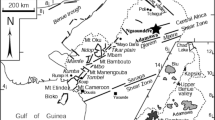Abstract
Pumice beds of the Maragheh Formation, which is distributed on the plains at the foot of the late Cenozoic Sahand volcano, NW Iran, consist of the Mordaq tuff bed, lower pumice beds (A and B), middle pumice bed and upper pumice bed, in ascending order. New hornblende and plagioclase K–Ar ages of the pumices from these are: Mordaq tuff bed: 8.14 ± 0.27 Ma, lower pumice beds (A): 7.54 ± 0.22 Ma, lower pumice beds (B): 6.95 ± 0.28 Ma, middle pumice bed: 7.87 ± 0.29 Ma, upper pumice bed: 6.96 ± 0.31 Ma. The middle pumice bed is a flood deposit, and the chemical compositions of glass, hornblende and biotite in pumices overlap those from the lower pumice beds (A). These features indicate that the pumices of the middle pumice bed were derived from a similar source to the lower pumice beds (A). Chemical compositions of pumices from the Maragheh Formation fall in the dacite field of the total alkali-silica (TAS) classification diagram and slightly differ from those of the Plio–Pleistocene rocks from the Sahand volcano. Chemical compositions of late Miocene Maragheh Formation pumices show adakitic features with high Sr contents (698–545 ppm), and low Y (12–8 ppm). It is inferred that the source materials of the adakitic dacite magma were amphibole eclogite or garnet amphibolite originating from the Neo-Thetys plate subducted beneath the Eurasia plate.


















Similar content being viewed by others
References
Alishah, F. P., & Jahangiri, A. (2013). Post-collisional Pliocene to Pleistocene adakitic volcanism in Sahand region in Northwest Iran: Geodynamic implications. Physical Science Research International, 1, 62–75.
Azizi, H., & Moinevaziri, H. (2009). Review of the tectonic setting of Cretaceous to Quaternary volcanism in northwestern Iran. Journal of Geodynamics, 47, 167–179.
Azizi, H., Asahara, Y., Tsuboi, M., Takemura, K., & Razyani, S. (2014). The role of heterogenetic mantle in the genesis of adakites northeast of Sanandaj, northwestern Iran. Chemie der Erde, 74, 87–97.
Bernor, R. L. (1986). Mammalian biostratigraphy, geochronology, and zoogeographic relationships of the Late Miocene Maragheh fauna, Iran. Journal of Vertebrate Paleontology, 6, 76–95.
Bernor, R. L., Woodbune, M. O., & Couvering, J. A. (1980). A contribution to the chronology of some Old World faunas based on hipparionene horses. Geobios, 13, 25–59.
Bernor, R. L., Solounias, N., Swisher, C. C., III, & Van Couvering, J. A. (1996). The correlation of three classical “Pikermian” mammal faunas-Maragheh, Samos and Pikermi—with the European MN unit system. In R. L. Bernor, V. Fahlbusch, & H. W. Mittmann (Eds.), The evolution of Western Eurasian Neogene mammal faunas (pp. 137–156). New York: Columbia University Press.
Campbell, B. G., Amini, M. H., Bernor, R. L., Dickenson, W., Drake, W., Morris, R., Van Couvering, J. A., & Van Couvering, J. A. H. (1980). Maragheh: a classical late Miocene vertebrate locality in northwestern Iran. Nature, 287, 837–841.
Castillo, P. R. (2012). Adakite petrogenesis. Lithos, 134–135, 304–316.
Chiu, H.-Y., Chung, S.-L., Zarrinkoub, M. H., Mohammadi, S. S., Khatib, M. M., & Iizuka, Y. (2013). Zircon U-Pb age constraints from Iran on the magmatic evolution related to Neothyan subduction and Zagros orogeny. Lithos, 162–163, 70–87.
de Mecquenem, R. (1908). Contribution å l’tude du gisement des vert brs de Maragha et de ses environs. Annales Histoire Naturelle, 1, 27–79.
Defant, M. J., & Drummond, M. S. (1990). Derivation of some modern arc magmas by melting of young subducted lithosphere. Nature, 347, 662–665.
Defant, M. J., Jackson, T. E., Drummond, M. S., De Boer, J. Z., Bellon, H., Feigenson, M. D., Maury, R. C., & Stewart, R. H. (1992). The geochemistry of young volcanism throughout western Panama and southeastern Costa Rica: an overview. Journal of the Geological Society (London), 149, 569–579.
Dokuz, A., Uysal, I., Siebel, W., Turan, M., Duncan, R., & Akçay, M. (2013). Post-collisional adakitic volcanism in the eastern part of the Sakarya Zone, Turkey: evidence for slab and crustal melting. Contribution to Mineralogy and Petrology, 166, 1443–1468.
Erdbrink, D. P. B., Priem, H. N. A., Hebeda, E. H., Cup, C., Dankers, P. O., & Cloetingh, S. A. P. L. (1976). The bone bearing beds near Maragheh in N.W. Iran. Proceedings Koninklijke Nederlandse Akademie van Wetenschappen, B 79(2), 85–113.
Eronen, J.T., Mirzaie Ataabadi, M., Micheels, A, Karme, A., Bernor, R.L, & Fortelius, M. (2009). Distribution history and climatic controls of the Late Miocene Pikermian Chronofauna, Proceedings of the National Academy of Sciences, 106, 11867-11871.
Eyuboglu, Y., Santosh, M., & Chung, S.-L. (2011). Crystal fractionation of adakitic magmas in the crust-mantle transition zone: petrology, geochemistry and U-Pb ziron chronology of the Seme adakites, eastern Pontides, NE Turkey. Lithos, 121, 151–166.
Ghalamghash, J., & Chaharlang, R. (2014). Petrogenesis and tectonic setting of Sahand subvolcanic and volcanic domes. Petrology, 5, 9–25. (Persian with English abstract)
Irvine, T. N., & Baragar, W. R. A. (1971). A guide to the chemical classification of the common volcanic rocks. Canadian Journal of Earth Sciences, 8, 523–548.
Itaya, T., Nagao, K., Inoue, K., Honjou, Y., Okada, T., & Ogata, A. (1991). Argon isotope analysis by a newly developed mass spectrometric system for K-Ar dating. Mineralogical Journal, 15, 203–221.
Jahangiri, A. (2007). Post-collisional Miocene adakitic volcanism in NW Iran: geochemical and geodynamic implications. Journal of Asian Earth Sciences, 30, 43–447.
Kaislaniemi, L., Hunen, J. H., Allen, M. B., & Nell, I. (2014). Sublithospheric small-scale convection—a mechanism for collision zone magmatism. Geology, 42, 291–294.
Kamei, T., Ikeda, J., Ishida, H., Ishida, S., Onishi, I., Partoazar, H., Sasajima, S., & Nishimura, S. (1977). A general report of the geological and paleontological survey in Maragheh area, north-west Iran, 1973. Memoir Faculty of Science, Kyoto University, Series Geology & Mineralogy, Vol. XLIII, No. 1/2, 131–164, Pls 7–9.
Karimzadeh Somarin, A. (2004). Marano volcanic rocks, East Azarbaijan Province, Iran, and associated Fe mineralization. Journal of Asian Earth Sciences, 24, 11–23.
Karsli, O., Dokuz, A., Uysal, I., Aydin, F., Kandemir, R., & Wijbrans, J. (2010). Generation of the Early Cenozoic adakitic volcanism by partial melting of mafic lower crust, Eastern Turkey: implications for crustal thickening to delamination. Lithos, 114, 109–120.
Khalaji, A. A., Esmaeily, D., Valizadeh, M. V., & Rahimpour-Bonab, H. (2007). Petrology and geochemistry of the granitoid complex of Boroujerd, Sanandaj-Sirjan Zone, Western Iran. Journal of Asian Earth Sciences, 29, 859–877.
Kheirkhah, M., Neill, I., & Allen, M. B. (2015). Petrogenesis of OIB-like basaltic volcanic rocks in a continental collision zone: Late Cenozoic magmatism of Eastern Iran. Journal of Asian Earth Sciences, 106, 19–33.
Kimura, J., & Yamada, Y. (1996). Evaluation of major and trace elements XRF analyses using a flux to sample ratio of two to one glass beads. Journal of Mineralogy, Petrology and Economic Geology, 91, 62–72.
Kittl, E. (1885). Die fossile Saugethier-fauna von Maragha in Persien. Verhandlungen der K. K. Geologischen Reichsanstalt, 1885, 397–399.
Kostopolous, D. S. (2009). The Pikermian Event: temporal and spatial resolution of the Turolian large mammal fauna in SE Europe. Palaeogeography, Palaeoclimatology, Palaeoecology, 274, 82–95.
Le Bas, M. J., Le Maitre, R. W., Streckeisen, A., & Zanettin, B. (1986). A chemical classification of volcanic rocks based on the total alkali-silica diagram. Journal of Petrology, 27, 745–750.
Lydekker, R. (1886). On the fossil mammalia of Maragha in Northwest Persia. Quarterly Journal of Geological Society of London, 42, 173–176.
Marchev, P. M., Georgiev, S., Raicheva, R., Peytcheva, I., Quadt, A., Ovtcharova, M., & Bonev, N. (2013). Adakitic magmatism in post-collisional setting: an example from the Early-Middle Eocene Magmatic Belt in Southern Bulgaria and Northern Greece. Lithos, 180–181, 159–180.
Martin, H. (1999). Adakitic magmas: modern analogues of Archaean granitoids. Lithos, 46, 411–429.
Martin, H., Smithies, R. H., Rapp, R., Moyen, J.-F., & Champion, D. (2005). An overview of adakite, tonalite-trondhjemite-granodiorite (TTG), and sanukitoid: relationships and some implications for crustal evolution. Lithos, 79, 1–24.
Mecquenem, R. de. (1924–25). Contnbution l’tude des fossiles de Maragha. Annales Pa1onto1ogie Vertebres, 13/14, 135–160.
Mirzaie Ataabadi, M., Liu, L., Eronen, J. T., Bernor, R. L., & Fortelius, M. (2013a). Continental scale patterns in Neogene mammal community evolution and biogeography: a Europe-Asia perspective. In W. Xiaoming, M. Fortelius, & L. Flynn (Eds.), Asian Neogene mammal biostratigraphy and chronology (pp. 629–655). New York: Columbia University Press.
Mirzaie Ataabadi, M., Bernor, R. L., Kostopolus, D., Wolf, D., Orak, Z., Zaree, G., Nakaya, H., Watabe, M., & Fortelius, M. (2013b). Recent advances on paleobiological research of the Late Miocene Maragheh Fauna, Northwest Iran. In W. Xiaoming, M. Fortelius, & L. Flynn (Eds.), Asian Neogene mammal biostratigraphy and chronology (pp. 544–563). New York: Columbia University Press.
Moinevaziri, H. (1985). Volcanisme Tertiaire et Quaternaire en Iran (p. 290). Paris-Sud Orsay: These d’ Etat.
Nagao, K., Nishido, H., Itaya, T., & Ogata, K. (1984). K-Ar age determination method. Bulletin of Hiruzen Research Institute, 9, 19–38 (in Japanese).
Neill, I., Meliksetian, K., Allen, M. B., Navarsardyan, G., & Karapetyan, S. (2013). Pliocene-Quaternary volcanic rocks of NW Armenia: magmatism and lithospheric dynamics within and an active orogenic plateau. Lithos, 180–181, 200–215.
Omrani, J., Agard, P., Whitechuch, H., Benoit, M., Prouteau, G., & Joilivet, L. (2008). Arc-magmatism and subduction history beneath the Zagros Mountains, Iran: a new report of adakites and geodynamic consequences. Lithos, 106, 380–398.
Peccerillo, A., & Taylor, S. R. (1976). Geochemistry of Eocene calc-alkaline volcanic rocks from the Kastamonu area, northern Turkey. Contribution to Mineralogy and Petrology, 58, 63–81.
Pohlig, H. (1886). On the Pliocene of Maragheh, Persia, and its resemblance to that of Pikermi in Greece; on fossil elephant remains of Caucasia and Persia; and on the results of a monograph of the fossil elephants of Germany and Italy. Quarterly Journal of Geological Society of London, 42, 177–182.
Richards, J. P. (2015). Tectonic, magmatic, and metallogenic evolution of the Tethyan orogeny: from subduction to collision. Ore Geology Reviews, 70, 323–345.
Rollinson, H.R. (1993). Using geochemical data: evaluation, presentation, interpretation. Longman Singapore Publishers LTD. 352pp.
Sakai, T., Zaree, G., Sawada, Y., Mirzaie Aataabadi, M., & Fortelius, M. (2016), Preliminary results of depositional environment reconstruction of the Maragheh Formation, East Azerbaijan, Northwestern Iran. In: Majid M. Ataabadi and Mikael Fortelius (Eds.) The Late Miocene Maragheh mammal fauna; results of recent multidisciplinary research. Palaeobiodiversity and Palaeoenvironments, 96(3). doi:10.1007/s12549-016-0238-z.
Somarin, A. K. (2004). Marono volcanic rocks, East Azerbaijan Province, Iran, and associated Fe mineralization. Journal of Asian Earth Sciences, 24, 11–23.
Steiger, R., & Jäger, E. (1977). Subcommission on geochronology: convention on the use of decay constants in geo- and cosmo-chronology. Earth and Planetary Science Letters, 36, 359–62.
Suwa, G., Kunimatsu, Y., Mirzaie Ataabadi, M., Orak, Z., Zaree, G., Sasaki, T. and Fortelius, M. (2016) The first hominoid from the Maragheh Formation, Iran. In: Majid M. Ataabadi and Mikael Fortelius (Eds.) The Late Miocene Maragheh mammal fauna; results of recent multidisciplinary research. Palaeobiodiversity and Palaeoenvironments, 96(3). doi:10.1007/s12549-016-0234-3.
Swisher, C. C., III. (1996). New 40Ar/39Ar dataes and their contribution toward a revised chronology for the Late Miocene of Europe and west Asia. In R. L. Bernor, V. Fahlbusch, & H. W. Mittmann (Eds.), The evolution of western Eurasian Neogene mammal faunas (pp. 64–77). New York: Columbia University Press.
Topuz, G., Okay, A. I., Altherr, R., Schwarz, W. H., Siebel, W., Zack, T., Satir, M., & Sen, C. (2011). Post-collsional adakite-like magmatism in the Agvanis Massif and implications for the evolution of the Eocene magmatism in the Eastern Pontids (NE Turkey). Lithos, 125, 131–150.
Varol, E., Temel, A., Gourgaud, A., & Bellon, H. (2007). Early Miocene adakite-like volcanism in the Balkuyumcu region, central Anatolia, Turkey: petrology and geochemistry. Journal of Asian Earth Sciences, 30, 613–628.
Wang, Q., Wyman, D. A., Zhao, Z.-H., Xu, J.-F., Bai, Z.-H., Xiong, X.-L., Dai, T.-M., Li, C.-F., & Chu, Z.-Y. (2007). Petrogenesis of Carboniferous adakites and Nb-enriched arc basalts in Alataw area, northern Tianshan Range (western China): implications for Phanerozoic crustal growth in the Central Asia orogenic belt. Chemical Geology, 236, 42–64.
Watabe, M., & Nakaya, H. (1991a). Phylogenetic significance of the postcranial skeletons of the hipparions from Maragheh (late Miocene, Northwest Iran). Memoirs of the Faculty of Science. Kyoto University. Series of Geology and Mineralogy, 56(1/2), 11–53.
Watabe, M., & Nakaya, H. (1991b). Cranial skeleton of Hipparion (Perissodactyla, Mammalia) from Maragheh (Turolian, late Miocene), Northwest Iran. Memoirs of the Faculty of Science. Kyoto University. Series of Geology and Mineralogy, 56(1/2), 55–125.
Acknowledgements
The Department of Environment (environment protection organisation) of the Government of Iran permitted and facilitated this study. We would like to express our gratitude to the former and present heads of the “Natural Environment Division” of this organisation as well as those of the “Office of Natural History Museum, Biodiversity and Genetic Resources” for their support. We also appreciate assistance from the Maragheh governor, mayor, city council, DOE office and participants of the field workshops held in Maragheh during 2007–2009. MMA, MF and field work in Maragheh were partially supported by the Academy of Finland, RHOI project and the Sasakawa Foundation. We thank Dr. B. Roser for discussion and critical reading of the manuscript, Dr. A. Kamei of Shimane University for discussion about adakites, and Ms. Y. Oshima for her preparation of polished thin sections. We wish to thank the reviewers Dr. Masafumi Sudo (Universität Potsdam, Germany) and Dr. Maryam Honarmand (Institute for Advanced Studies in Basic Sciences, Iran) for their critical reading of the manuscript and very helpful comments.
Author information
Authors and Affiliations
Corresponding author
Additional information
This article is a contribution to the special issue "The late Miocene Maragheh mammal fauna; results of recent multidisciplinary research"
Rights and permissions
About this article
Cite this article
Sawada, Y., Zaree, G.R., Sakai, T. et al. K–Ar ages and petrology of the late Miocene pumices from the Maragheh Formation, northwest Iran. Palaeobio Palaeoenv 96, 399–431 (2016). https://doi.org/10.1007/s12549-016-0232-5
Received:
Revised:
Accepted:
Published:
Issue Date:
DOI: https://doi.org/10.1007/s12549-016-0232-5




